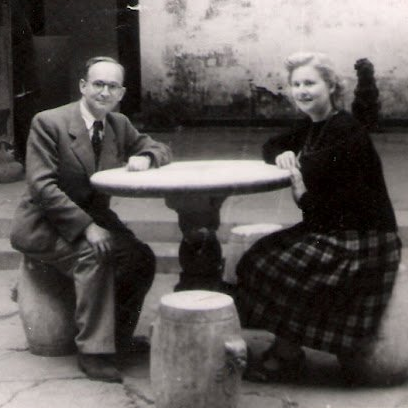The story of Victor and Eva Saxl is a testament to Resilience and Faith
The story of Victor and Eva Saxl is a testament to resilience and faith. Despite facing the horrors of the Holocaust, World War II, and Eva's incurable type 1 diabetes, their love and belief in God they found a way to not only survive, but to thrive.
Their lives began in Czechoslovakia, where they married in 1940. Eva, fluent in eight languages , and Victor, a textile engineer, were forced to flee the Nazi invasion. Along with 18,000 other Jewish refugees, they journeyed via the Suez Canal to Shanghai. In the Jewish ghetto, they established a life, Eva teaching languages and Victor working in a woollen mill.
An excerpt from an essay written by Eva reflects their initial optimism despite the Japanese occupation of Shanghai since 1937: "People of all races and creeds lived and worked together... I found out that most people are kind and good." She noted the importance of speaking Chinese to connect with people and learn their philosophy. However, their relative peace was shattered when Eva was diagnosed with type 1 diabetes at the age of 20, less than a year after arriving in Shanghai.
Type one diabetes is an autoimmune disease, meaning the person’s own immune system has attacked and destroyed the specialized cells in the body that are responsible for making insulin. Insulin is the key that opens the door to a person's cells so that sugar can get in and feed the cell. Without that “key”, the person will die a slow, horrible death. Thankfully, 20 years before her diagnosis, in 1921, two Canadian researchers, Sir Frederick Banting and Charles Best had found a way to isolate insulin, and make it available to people with type one diabetes.
Initially, Eva had access to insulin, but the bombing of Pearl Harbor disrupted international medicine shipments. Eva and about 400 others with type 1 diabetes rationed their dwindling supplies, maintained a starvation diet, and resorted to the dangerous black market. Victor recounted the desperation: "The situation was desperate. The black market was our only source... Once I traded a gold bar worth $80 for 18 bottles of insulin. It was worthless, and it was so painful that Eva screamed when I injected it into her." Kentrucky New Era - Nov 6, 1951
Witnessing the rising death toll, Victor pleaded with the indifferent Japanese military and then the Chinese Health Ministry to produce insulin. While the Chinese were interested, scientists were hesitant to attempt such a risky experiment. For Victor and Eva, it was not academic, it was a matter of survival.
With the help of a supportive Chinese food chemist who provided a basement laboratory, and armed with medical supplies and textbooks (which Eva could read in multiple languages), Victor embarked on the daunting task of producing insulin himself, following the procedures of Banting and Best. Eva recalled later:
“Many diabetics had already died, and the situation became desperate. Throughout all of it, I never stopped believing that with the help of God and my husband’s love and care, I would survive”.
Eva and a friend made frequent visits to a slaughterhouse and bought the pancreases of water buffalos, crushed the organs with Eva’s mother’s old meat grinder. Victor worked to isolate insulin with an old centrifuge, alcohol and ice.
The first batch of insulin was brown and cloudy, probably not unlike the first few batches produced by Banting and Best, 20 years before in a lab at the University of Toronto. With only a few days left of Eva’s supply of insulin, Victor injected his batch into Eva.
Victor remembered it this way:
”Our friends gathered at our house and we watched excitedly for Eva’s reaction. Imagine our happiness when after several hours, the drug began to take effect” Kentrucky New Era - Nov 6, 1951
As soon as Victor saw his wife’s encouraging reaction to the batch of insulin, he immediately ran out the door to a local hospital where he knew there were two young men lying in a diabetic coma, close to death and administered the new insulin. Both of these patients recovered and one of them named his first child after Victor. Those who are familiar with the account, may remember reading how Dr. Banting saved a whole ward of children in diabetic comas, with his own batch of insulin. The similarity to the two accounts is heart wretching similar.
The Saxl’s wasted no time setting up their own clinic, producing insulin for anyone who needed it, free of charge. Syringes were reused and sharpened, and they took donations of ice and alcohol. They continued to make insulin, even through the days of bombing of power stations by the Americans, right up until the end of the war. Between 1942 and 1945, they had saved about 420 people.
When the Americans liberated Shanghai, the Saxls finally saw their first vial of clear insulin for the first time in three years. When they later emigrated to New York, their story gathered attention. Eva became a spokesperson for the American Diabetes Association, working to destigmatize the disease and inspire others to live a happy, fulfilled life. The couple was introduced to President Eisenhower at the White House and later met Dr. Best, whose lab notes they had used to create insulin in China.
Years later she wrote:
"Besides my trust in God, I derived the greatest strength from the deep love and complete understanding between my husband and me. And next to that was the kindness and help of many, many friends of many nationalities. Even some Japanese civilians, although their country was at war with us, helped whenever they could. To me, who lived under enemy occupation, freedom has a special meaning. My dreams came true when we were sailing toward the United States, where life, liberty, and the pursuit of happiness are the rights of every human being."
Their pursuit of happiness in America was later marked by tragedy when Victor died of a heart attack at age 58 in 1968 while on a UN mission in South America, which Eva accompanied to visit her brother in Chile. Devastated but resilient, Eva remained in Chile with her brother, her only surviving family member due to the Holocaust. She dedicated her life to helping others, especially poor children needing medication. She continued to educate and received the Charles H. Best Medal in 1991.
Eva passed away in 2002 at the age of 81. Her life, marked by immense challenges, exemplified unwavering faith, profound love, and a deep appreciation for humanity. She believed that her upbringing, including her education in languages and travel, fostered tolerance and helped her overcome life's difficulties. She said so herself in this excerpt:
“I believe that it is important to be brought up with a firm belief in the good. I was fortunate in this respect. My parents not only gave me a happy home, but they had me study half a dozen foreign languages and made it possible for me to travel in other countries. This made me more tolerant and helped me to bridge many difficulties in later life.”
Recognizing the constant burden of managing diabetes, Eva's story, along with Victor's unwavering dedication, offers a powerful message of hope and inspiration to those living with or alongside the disease, demonstrating that survival and even triumph are possible against incredible odds. Thank you Victor and Eva, for your story and for sharing it with the world. Thank you for never giving up.
References:
https://www.diabetes.co.uk/blog/2015/06/diabetes-legends-one-eva-saxl/
https://www.diabetes.co.uk/blog/2015/06/diabetes-legends-one-eva-saxl/
https://news.google.com/newspapers?id=zOErAAAAIBAJ&sjid=12UFAAAAIBAJ&pg=1629%2C3743614
https://www.rciscience.ca/100-lives/eva-saxl
https://hekint.org/2024/12/19/they-made-their-own-insulin-the-story-of-eva-and-viktor-saxl/
YouTube P https://youtu.be/xlOBl_nEits?si=N45AQhA1ARZEfgv3
Essay by Eva:
https://thisibelieve.org/essay/16957/


0 Comments
There are no comments for this article. Be the first one to leave a message!